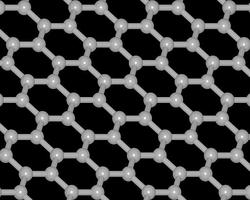Towards the optimal performance of graphene chips
A collaboration of CFEL scientist Arya Fallahi with Ecole Polytechnique Fédérale in Lausanne, Switzerland, led to the foundation of maximum theoretical limits in the efficiency of graphene non-reciprocal devices as a function of the material quality. This theoretical approach leads to the development of design methodologies for future high frequency circuits and chips operating based on the promising properties of graphene.
Graphene's two-dimensional honeycomb-shaped lattice made up of carbon atoms
Image: Joerg Harms, MPSD/CFEL
The discovery of graphene with its amazing properties opens new venues towards the fabrication of new computer chips with faster performance and simultaneously less power consumption. In recent years, various configurations of graphene devices have been studied and proposed for the realization of modulators, polarization rotators, absorbers, filters and isolators. However, a crucial question is raised after all these studies: What is the optimum performance achievable for a device employing graphene with quality levels obtained from a certain fabrication process?
Within the framework of a collaboration between the group of professor Julien Perruisseau-Carrier from Adaptive MicroNano Wave Systems at the Ecole Polytechnique Fédérale de Lausanne (EPFL) and Dr. Arya Fallahi, a DESY research scientist at the Ultrafast Optics and X-rays Division of CFEL, PhD student Michele Tamagnone (EPFL) has developed a new approach which allows the following conclusion: the maximum theoretical efficiency of the system is solely a function of the quality of the graphene.
By playing with the design, it is possible to approach this ceiling, but there is no way it can be surpassed. The scientists have thus managed to develop a method for precisely determining which design is the most appropriate for a given quality of graphene. Their results have been published in the journal Nature Photonics.
